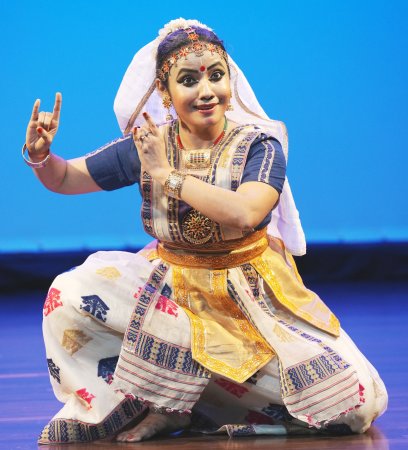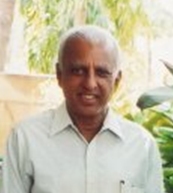
|   |

|   |
Living the Past, Dancing in the Present - Sattriya dance by Dr.Anwesa Mahanta - Satish Suri e-mail: satishism@yahoo.co.in Photos: Prof. K.S. Krishnamurthy July 15, 2024 Dr. Anwesa Mahanta's exploration of the salient features of Sattriya dance on the 20th of June at the Bangalore International Centre was an event of endearment and information. The presentation titled 'Living the Past, Dancing in the Present,' offered an illustrated lecture demonstration of the Sattriya dance tradition of Assam. Before her performance, Anwesa Mahanta provided an insightful introduction to the origin of the Sattriya dance, enriched with slides and videos of archival material. She emphasized that Sattriya was founded by the great saint poet Srimanta Sankardeva in the 15th-16th century. This unique art form is a harmonious blend of theatre, music, dance, and bhakti, with its prose and poetry composed in Sanskrit, Assamese, and Brajbuli, showcasing the vast creative expanse of Sattriya dance. Sankardeva's efforts were pivotal in spreading the philosophy of Bhakti, emphasizing devotion to Lord Krishna and fostering a cultural and spiritual renaissance in Assam. Through his innovative use of the arts, he created a vibrant cultural movement that has left a lasting legacy. Originally practised within the Sattras of Assam as an offering to Lord Krishna, Sattriya was traditionally performed by male monks. However, the dance form has evolved, and women now actively participate, bringing Sattriya to life on the proscenium stage while preserving its spiritual essence. Sattriya dance is deeply rooted in the Vaishnava Bhakti movement and draws inspiration from ancient scriptures and texts. It has a rich repertoire that includes dance dramas based on legends and mythologies of Krishna, particularly from texts like the Bhagavata Purana. The dance form incorporates expressive storytelling, intricate footwork, graceful movements, and hand gestures. While Sattriya has evolved and diversified its themes beyond mythology, it has remained true to its origins and spiritual significance. It continues to be a living tradition, practised with devotion and reverence by both monks and non-monastic dancers. The dance form has gained popularity and recognition, representing the cultural heritage of Assam and its vibrant artistic traditions.  Anwesa Mahanta Anwesa Mahanta elaborated on the dance's distinctiveness through its foundational stances: the masculine Purush Pak and the feminine Prakriti Pak, which are central to the dance's narrative and aesthetic expressions. The mnemonic bols, or rhythmic syllables, along with the soulful Borgeet music, large cymbals, and drums, create an immersive auditory experience that complements the visual splendour of the dance. The vibrant costumes and intricate choreography, which utilize a variety of talas or rhythmic cycles, add layers of complexity and beauty to the performances. Moreover, the dance dramas of Sattriya are unique for their incorporation of vachikabhinaya, where dialogues enhance the storytelling and the use of special masks that bring mythological characters to life. This dance form not only entertains but also serves as a conduit for spiritual and philosophical narratives, making it a treasured component of India's classical dance heritage. Anwesa Mahanta began her performance with "Vandana - Dhanya Dhanya Bharatavarshe", a profound tribute to the cultural and spiritual heritage of India. It began with an invocation to the revered figures of Srimanta Sankaradeva and Madhavadeva, setting a tone of reverence and devotion. The exploration of 'Bharatavarsha' reflected a deep national consciousness, connecting the audience to the philosophical roots of the nation. The inclusion of the Bhatiyali raga and Ektal rhythm enriched the performance with traditional musical elements that resonate with the soul of Indian classical music. The dancer drew reference from the repertoire of ritual service and beyond, demonstrating the nritta sequence of Chali Ramdani. Chali Nach represents the grace and elegance of the Prakriti representation of the universe, invoking feminine energy. In Ramdani, which belongs to the female repertoire of Sattriya dance, the dancer explored various stylistic patterns of Sattriya movement, creating a dance narrative of joy. Starting with a slow rhythm, it gradually culminated into brisk body movements. The performance was set to Kirtana rendition and Chuta Tala. The nritta sequence of Chali Ramdani and the Geetar Nach sequence highlighted the intricate dance techniques and the expressive potential of the Sattriya dance. Geetar Nach, a significant element of the Sattriya dance tradition, is a profound expression of the Vaishnavite philosophy, which emphasizes devotion to Lord Vishnu and his incarnations, such as Krishna. The Borgeet "Jaya Jaya Jadava Jalanidhi," composed by the saint-poet Sankardeva, encapsulated this devotional sentiment through its lyrical celebration of the divine. Set to the Asowari raga known for its serene and introspective mood, the composition resonated with a sense of yearning and devotion. Accompanied by Ektal, a rhythmic cycle of twelve beats divided into six sections, the dance performance created a meditative atmosphere that allowed the audience to immerse themselves in the spiritual narrative being depicted. The intricate footwork and expressive gestures of the dancer brought to life the poetic verses, creating a visual representation of the philosophical themes woven into the Borgeet. In "Govinda Dugdha Piyo," the abhinaya piece of Geetar Nach, the dancer portrayed a playful dialogue between Yashoda and little Krishna, based on a Borgeet by Madhavadeva, set to the raga Shyam and Parital rhythm. The child adamantly refuses to drink milk, while the mother tries various creative ways to feed her child. Through expressive movements and emotions, the dancer brought out the essence of the scene.  Anwesa Mahanta Later in the performance, the dancer incorporated the reference to the 'Kankhowa demon' episode, as found in the Kirtana Ghosa by Srimanta Sankaradeva. Krishna, during the dialogue, expresses his surprise and curiosity about this demon that he has never encountered before. However, he soon realizes the creativity and love of Yashoda in trying to engage him and nourish him. In a gesture of respect and gratitude, Krishna pays his respects to Yashoda. The performance beautifully brought out the emotions and storytelling elements of the episode, further enriching the overall presentation. Anwesa concluded her performance with "Bhagavata Dasha Lakshana" set in raga Bhatiyali and a series of talas. The Bhagavata Purana is a profound spiritual text that has inspired countless individuals through its rich narratives and philosophical teachings. Anwesa Mahanta's Sattriya dance performance was a beautiful embodiment of the Purana's 'Dasha Lakshana' or ten characteristics, which are essential to understanding the Bhakti tradition. Each aspect, from Sarga (creation), Visarga (subsequent creation), Sthana (sustenance), Poshana (grace and compassion), Uti (destiny and sagacity), Manavantara (transmigration and rebirth), Ishana (incarnation and eradication of evil), Nirodhana (return to Godhead and ego destruction), Mukti (liberation), to Ashraya (divine shelter), was meticulously represented through the intricate movements and expressions of the dance, capturing the essence of creation, sustenance, and liberation. This artistic interpretation not only preserves the cultural heritage but also makes the ancient wisdom accessible to contemporary audiences, allowing them to experience the timeless messages of the Bhagavata Purana dynamically and engagingly.  Bangalore based Satish Suri is an avid dance rasika besides being a life member of the Music and Arts Society. |